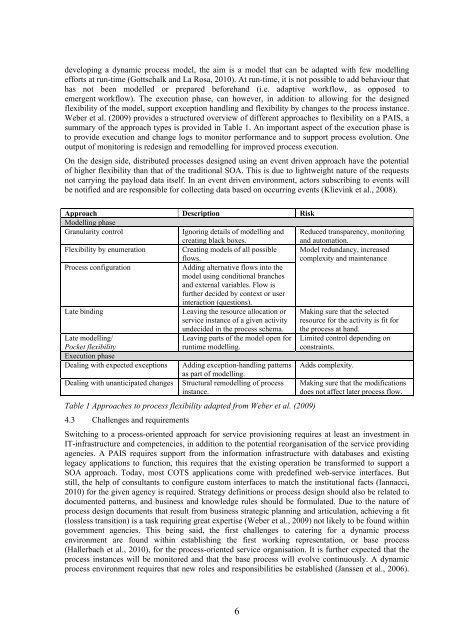Multi-channel provisioning of public services - Department of ...
Multi-channel provisioning of public services - Department of ...
Multi-channel provisioning of public services - Department of ...
You also want an ePaper? Increase the reach of your titles
YUMPU automatically turns print PDFs into web optimized ePapers that Google loves.
developing a dynamic process model, the aim is a model that can be adapted with few modelling<br />
efforts at run-time (Gottschalk and La Rosa, 2010). At run-time, it is not possible to add behaviour that<br />
has not been modelled or prepared beforehand (i.e. adaptive workflow, as opposed to<br />
emergent workflow). The execution phase, can however, in addition to allowing for the designed<br />
flexibility <strong>of</strong> the model, support exception handling and flexibility by changes to the process instance.<br />
Weber et al. (2009) provides a structured overview <strong>of</strong> different approaches to flexibility on a PAIS, a<br />
summary <strong>of</strong> the approach types is provided in Table 1. An important aspect <strong>of</strong> the execution phase is<br />
to provide execution and change logs to monitor performance and to support process evolution. One<br />
output <strong>of</strong> monitoring is redesign and remodelling for improved process execution.<br />
On the design side, distributed processes designed using an event driven approach have the potential<br />
<strong>of</strong> higher flexibility than that <strong>of</strong> the traditional SOA. This is due to lightweight nature <strong>of</strong> the requests<br />
not carrying the payload data itself. In an event driven environment, actors subscribing to events will<br />
be notified and are responsible for collecting data based on occurring events (Klievink et al., 2008).<br />
Approach Description Risk<br />
Modelling phase<br />
Granularity control<br />
Ignoring details <strong>of</strong> modelling and<br />
creating black boxes.<br />
Reduced transparency, monitoring<br />
and automation.<br />
Flexibility by enumeration Creating models <strong>of</strong> all possible<br />
flows.<br />
Model redundancy, increased<br />
complexity and maintenance<br />
Process configuration<br />
Adding alternative flows into the<br />
model using conditional branches<br />
and external variables. Flow is<br />
further decided by context or user<br />
interaction (questions).<br />
Late binding<br />
Leaving the resource allocation or<br />
service instance <strong>of</strong> a given activity<br />
undecided in the process schema.<br />
Making sure that the selected<br />
resource for the activity is fit for<br />
the process at hand.<br />
Late modelling/<br />
Pocket flexibility<br />
Execution phase<br />
Dealing with expected exceptions<br />
Dealing with unanticipated changes<br />
Leaving parts <strong>of</strong> the model open for<br />
runtime modelling.<br />
Adding exception-handling patterns<br />
as part <strong>of</strong> modelling.<br />
Structural remodelling <strong>of</strong> process<br />
instance.<br />
Table 1 Approaches to process flexibility adapted from Weber et al. (2009)<br />
4.3 Challenges and requirements<br />
Limited control depending on<br />
constraints.<br />
Adds complexity.<br />
Making sure that the modifications<br />
does not affect later process flow.<br />
Switching to a process-oriented approach for service <strong>provisioning</strong> requires at least an investment in<br />
IT-infrastructure and competencies, in addition to the potential reorganisation <strong>of</strong> the service providing<br />
agencies. A PAIS requires support from the information infrastructure with databases and existing<br />
legacy applications to function, this requires that the existing operation be transformed to support a<br />
SOA approach. Today, most COTS applications come with predefined web-service interfaces. But<br />
still, the help <strong>of</strong> consultants to configure custom interfaces to match the institutional facts (Iannacci,<br />
2010) for the given agency is required. Strategy definitions or process design should also be related to<br />
documented patterns, and business and knowledge rules should be formulated. Due to the nature <strong>of</strong><br />
process design documents that result from business strategic planning and articulation, achieving a fit<br />
(lossless transition) is a task requiring great expertise (Weber et al., 2009) not likely to be found within<br />
government agencies. This being said, the first challenges to catering for a dynamic process<br />
environment are found within establishing the first working representation, or base process<br />
(Hallerbach et al., 2010), for the process-oriented service organisation. It is further expected that the<br />
process instances will be monitored and that the base process will evolve continuously. A dynamic<br />
process environment requires that new roles and responsibilities be established (Janssen et al., 2006).<br />
6
















